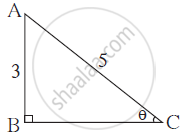Advertisements
Advertisements
प्रश्न
If sin θ + cos θ = `sqrt(3)`, then show that tan θ + cot θ = 1
उत्तर
sin θ + cos θ = `sqrt(3)` ......[Given]
∴ (sin θ + cos θ)2 = 3 ......[Squaring on both sides]
∴ sin2θ + 2sinθ cosθ + cos2θ = 3 ......[∵ (a + b)2 = a2 + 2ab + b2]
∴ (sin2θ + cos2θ) + 2sinθ cosθ = 3
∴ 1 + 2 sin θ cos θ = 3 ......[∵ sin2θ + cos2θ = 1]
∴ 2 sin θ cos θ = 2
∴ sin θ cos θ = 1 ......(i)
tan θ + cot θ = `sintheta/costheta + costheta/sintheta`
= `(sin^2theta + cos^2theta)/(costhetasintheta)`
= `1/(sintheta costheta)` ......[∵ sin2θ + cos2θ = 1]
= `1/1` ......[From (i)]
= 1
APPEARS IN
संबंधित प्रश्न
Prove that sin6θ + cos6θ = 1 – 3 sin2θ. cos2θ.
9 sec2 A − 9 tan2 A = ______.
Prove the following identities, where the angles involved are acute angles for which the expressions are defined.
`(sintheta - 2sin^3theta)/(2costheta - costheta) =tan theta`
Prove the following trigonometric identities.
(sec A − cosec A) (1 + tan A + cot A) = tan A sec A − cot A cosec A
Prove the following identities:
`sqrt((1 - sinA)/(1 + sinA)) = cosA/(1 + sinA)`
`sin^6 theta + cos^6 theta =1 -3 sin^2 theta cos^2 theta`
Write the value of`(tan^2 theta - sec^2 theta)/(cot^2 theta - cosec^2 theta)`
If `cos B = 3/5 and (A + B) =- 90° ,`find the value of sin A.

From the figure find the value of sinθ.
If tanθ `= 3/4` then find the value of secθ.
Prove the following identity :
`cosecA + cotA = 1/(cosecA - cotA)`
Prove the following identities:
`(sec"A"-1)/(sec"A"+1)=(sin"A"/(1+cos"A"))^2`
Prove that sin4θ - cos4θ = sin2θ - cos2θ
= 2sin2θ - 1
= 1 - 2 cos2θ
Prove that `( 1 + sin θ)/(1 - sin θ) = 1 + 2 tan θ/cos θ + 2 tan^2 θ` .
Prove the following identities.
`(1 - tan^2theta)/(cot^2 theta - 1)` = tan2 θ
Prove the following identities.
`sqrt((1 + sin theta)/(1 - sin theta)) + sqrt((1 - sin theta)/(1 + sin theta))` = 2 sec θ
Prove that `costheta/(1 + sintheta) = (1 - sintheta)/(costheta)`
Prove that `sintheta/(sectheta+ 1) +sintheta/(sectheta - 1)` = 2 cot θ
sin(45° + θ) – cos(45° – θ) is equal to ______.
Prove that `(1 + tan^2 A)/(1 + cot^2 A)` = sec2 A – 1
